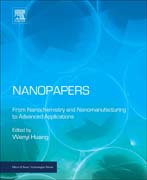
Nanopapers: From Nanochemistry, Nanomanufacturing to Advanced Applications
Huang, Wenyi
Nanopapers: From Nanochemistry, Nanomanufacturing to Advanced Applications gives a comprehensive overview of the emerging technology of nanopapers. Exploring the latest developments on nanopapers in nanomaterials chemistry and nanomanufacturing technologies, this book outlines the unique properties of nanopapers and their advanced applications. Nanopapers are thin sheets or films made of nanomaterials such as carbon nanotubes, carbon nanofibers, nanoclays, cellulose nanofibrils, and graphene nanoplatelets. Noticeably, nanopapers allow highly concentrated nanoparticles to be tightly packed in a thin film to reach unique properties such as very high electrical and thermal conductivities, very low diffusivity, and strong corrosion resistance that are shared by conventional polymer nanocomposites. This book presents a concise introduction to nanopapers, covering concepts, terminology and applications. It outlines both current applications and future possibilities, and will be of great use to nanochemistry and nanomanufacturing researchers and engineers who want to learn more about how nanopapers can be applied. Outlines the main uses of nanopapers, showing readers how this emerging technology should best be appliedShows how the unique properties of nanopapers make them adaptable for use in a wide range of applicationsExplores methods for the nanomanufacture of nanopapers INDICE: 1. From paper to nanopaper: evolution of mechanical and physical properties2. Graphene Nanopapers3. Graphene oxide nanopapers4. Carbon nanotube nanopapers5. Carbon nanofiber nanopapers6. Nanclay nanopapers7. Nanopaper: thin films prepared from polymer nanotubes8. Highly transparent all-cellulose nanopaper9. Microfibrillated cellulose-SiO2 composite nanopapers produced by spray deposition10. Cellulose nanofibers as ultra filtration membranes11. Synergistic catalysis Au-Cu/TiO2-NB nanopaper12. Electromagnetic Interference shielding effect of plastic parts using in mold coated nanopapers13. Rapid nanopaper production by spray deposition of concentrated microfibrillated cellulose slurries14. Room-temperature humidity-sensing performance of SiC nanopaper15. Water-resistant, transparent hybride nanopaper16. Oriented clay nanopaper from biobased components-mechanisms for superior fire protection properties17. Hierarchical carbon nanopapers coupled with ultrathin MoS2 nanosheets: Highly efficient large-area electrodes for hydrogen evolution18. Foldable electrochromoics enabled by nanopaper transfer19. Self-powered human-interactive transparent nanopaper systems20. Nanopaper as an optical sensing platform21. Photon energy unconverting nanopaper: a bioinspired oxygen protection strategy22. Nanopapers for organic solvent nanofiltration23. Electronspun nanopaper and its applications to microsystems24. Highly transparent and flexible nanopaper transistors25. Electrospun high temperature polyimide nanopaper
- ISBN: 978-0-323-48019-2
- Editorial: William Andrew
- Encuadernacion: Cartoné
- Páginas: 528
- Fecha Publicación: 01/09/2017
- Nº Volúmenes: 1
- Idioma: Inglés
